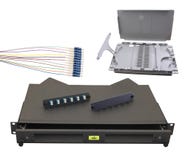

What is a FOBOT? How Does a FOBOT Work?
In this article, we will explain what a FOBOT is and where they are used. We will also describe how a FOBOT works and the important role this component plays in managing and distributing optical fibres efficiently. So, if you're looking to learn all about FOBOTs, make sure to read this article carefully.
What is a FOBOT?
FOBOT, or “Fibre Optic Break Out Tray,” is a device used in fibre optic networking to manage and organize optical fibres as they transition from a larger cable to individual fibres or smaller bundles. FOBOT is also known as a breakout box or fibre optic breakout panels.
These trays are commonly seen in data centres, telecommunication facilities, and other environments where fibre optic cables are deployed.
The primary purpose of a FOBOT is to facilitate the transition from a larger, multi-fibre cable to individual fibres or bundles while also offering protection. So, they always ensure efficient and reliable operation of the fibre optic network.
Now, we will move into the next segment of this informative article, where we will explain how a FOBOT works.
How does a FOBOT work?
In this section of this informative article, we will explain to you how the FOBOT or Fibre Optic Break Out Tray works. So, thoroughly review this section and eventually understand the actual working mechanism of the Fibre Optic Breakout Tray.
- First and foremost, larger fibre optic cables, often referred to as “trunk cables” or “main cables,” enter the breakout tray. These trunk cables contain multiple individual optical fibres.
- Inside the breakout tray, the outer jacket of the trunk cable is removed. This outer jacket is usually made of materials like PVC, LSZH Polyolefin or NE/Nylon. Removing it exposes the individual fibres or bundles within the cable.
- Once the outer jacket of the main cable is removed, the individual optical fibres or smaller bundles within the cable are separated. This process is known as “breaking out.”
- Fibres are organized within the breakout tray after the “breaking out” process for easier management and connection. The breakout tray also protects the individual fibres or bundles, helping prevent damage, bending, or twisting. This protection is essential for maintaining the optical signal quality.
- Within the breakout tray, fibre optic connectors are also attached to the individual fibres or bundles, allowing easy connection to other optical equipment, such as switches, routers, or patch panels.
- Breakout trays often include labeling options to identify each fibre, making it easier for technicians to manage and troubleshoot the network. Proper documentation of the connections is crucial for maintenance and future expansion.
- Breakout trays sometimes come with sealing mechanisms to protect the fibres from dust, moisture, or other contaminants. This feature is essential in environments with harsh conditions where maintaining the integrity of optical signals is paramount.
Conclusion
As promised at the beginning of this informative article, we have explained what a FOBOT is and also mentioned how a FOBOT works. So, thoroughly review this article to gather valuable information regarding “Fibre Optic Break Out Trays” and give our experienced team a call if you need further information.
Recent Articles

Test Network Cabling & Patch Cords FAST with the New DATATESTER by CABAC
Testing LAN cables is quick and easy when you’ve got the new CABAC DATATESTER on hand. This budget LAN cable tester is perfect for contractors who need to test data and coaxial cable for correct termination.
View Products
Exploring the Advantages of Thin Patch Leads
For Australian data installers, selecting the right network components is critical to achieving the performance and reliability that your customers expect. Among these components, the humble patch lead plays a crucial role in interconnecting various devices.
View Products
FOBOT Buying Guide
In this informative article, we will provide a basic buying guide for FOBOTs or “Fibre Optic Break Out Trays” so that you can choose the right product for your specific needs.
View Products
What is a FOBOT?
In this article, we will explain what a FOBOT is and where they are used. We will also describe how a FOBOT works and the important role this component plays in managing and distributing optical fibres efficiently. So, if you're looking to learn all about FOBOTs, make sure to read this article...
View Products
What is the difference between OS1 and OS2 Singlemode Optical Fibre?
This technical article delves into the differences between OS1 and OS2 Singlemode fibre optics, including their core characteristics, performance specifications, and ideal applications.
View Products




















